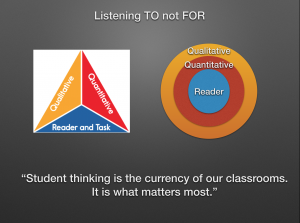 “Every teacher wants and expects his or her students to be reading increasingly complex texts, yet sometimes the gap between our expectations and our students’ abilities seems wide and deep. It’s tempting to look at that gap and step in to fill it for them, but then we’d be doing most of the ‘heavy lifting’–the understanding, analysis, and interpretation that our students should be learning for themselves.” With that small blurb on the back cover of Barnhouse’s Readers Front & Center: Helping All Students Engage with Complex Texts, she had me hooked.
“Every teacher wants and expects his or her students to be reading increasingly complex texts, yet sometimes the gap between our expectations and our students’ abilities seems wide and deep. It’s tempting to look at that gap and step in to fill it for them, but then we’d be doing most of the ‘heavy lifting’–the understanding, analysis, and interpretation that our students should be learning for themselves.” With that small blurb on the back cover of Barnhouse’s Readers Front & Center: Helping All Students Engage with Complex Texts, she had me hooked.
How do we get our students to dive into texts, to do the work of complex meaning-making, and to love reading? How do we nurture our love of teaching reading by listening closely to the thinking our students do as they read?
Join Our Book Club Conversation
If you’re interested in learning with us, pick up a copy of Barnhouse’s book. We are tackling through Chapter 3 by December 3, and we will post some thinking questions to spark discussion for the first part of the book here. (You can even subscribe to this blog by entering your school email in the box on the left side of the blog post and receive our discussion questions each week to your mailbox.)
Today’s questions come from the introduction in Barnhouse’s text, which she aptly names “Learning to Listen.”
- On pages 5-8 Barnhouse laments how the authors of the CCSS have given short shrift to the reader and task component of text complexity in how the standards have been rolled out. She shares the story of a boy reading an excerpt from Tom Sawyer who has no idea how to listen to the text. She claims the act of reading has been yanked out of context for the reader, similar to the excerpt being yanked out of the story: “There is no why, as in why should this student read this particular text; there is no how, as in how should this student read this particular text; and there is no so what, as in what’s the payoff for this student’s efforts”(p. 8). In your time with students, how do you connect them to the why, how, and so what of reading?
2. Barnhouse contends, “We cannot say that students are an important factor in determining text complexity and then create curricula that ignore students. We cannot say that students need to read independently and proficiently and then hand them texts they can’t read” (p.9). How do specialists support classroom teachers in teaching the reader, not the text?
Use the comments section to share your thinking!


I feel so strongly about the thoughts captured in the passage from pg. 9. Barnhouse is here suggesting we have been so distracted by the noise of the ‘policy churn’ that we have shifted our focus on the reading and not the reader. As a specialist, I feel if we are to follow the suggestion Barnhouse provides on p. 10 (“conduct reading conferences that allow us to truly teach from where our students are, first by listening to their thinking as they read and then rooting them in their own agency as learners”) and use those qualitative notes and noticings as catalysts to student ownership/interest in their reading development, we will see sustained growth as students develop into lifelong literate learners.
Thanks for sharing your thinking, Lindsay! I agree that slowing down and focusing on our conferring is a big piece of the puzzle in how we truly listen to students’ thinking. Honoring our qualitative data is something I hope we can refocus on as well. With the push toward EOCs and MAP test results, we often rely on paper and pencil data to draw conclusions about our students as readers, when we can know so much more about them through conferring or in small group interactions.